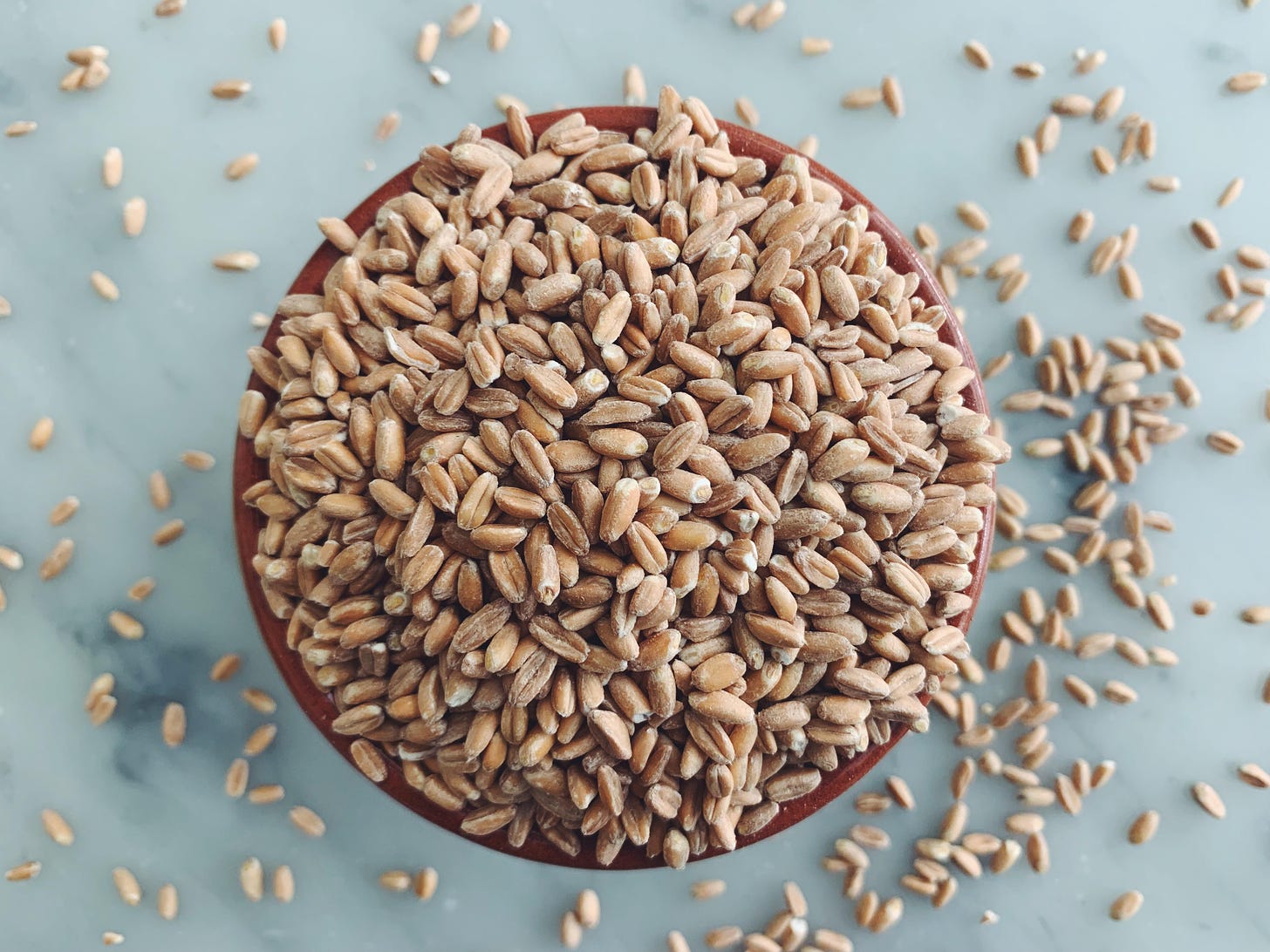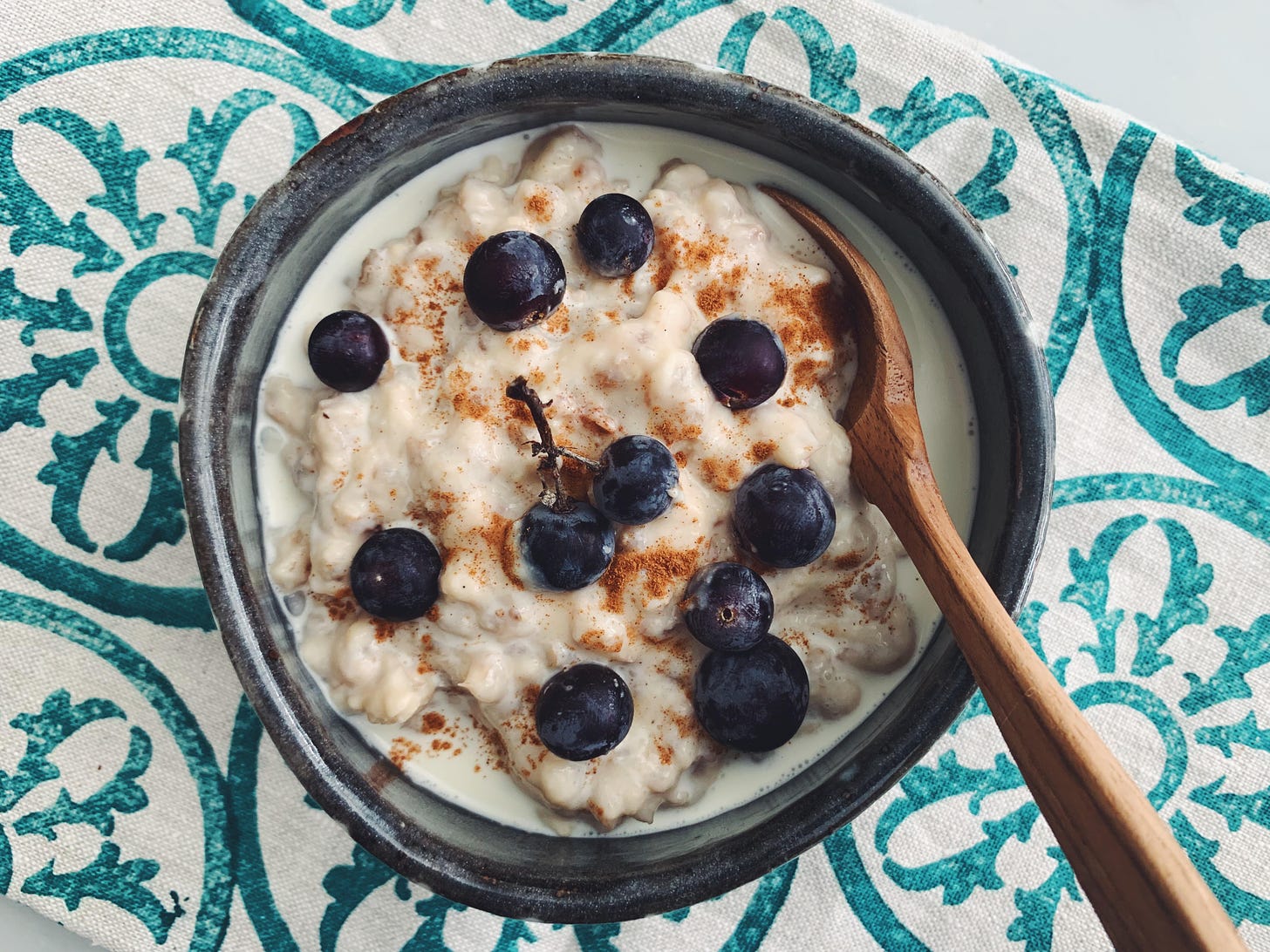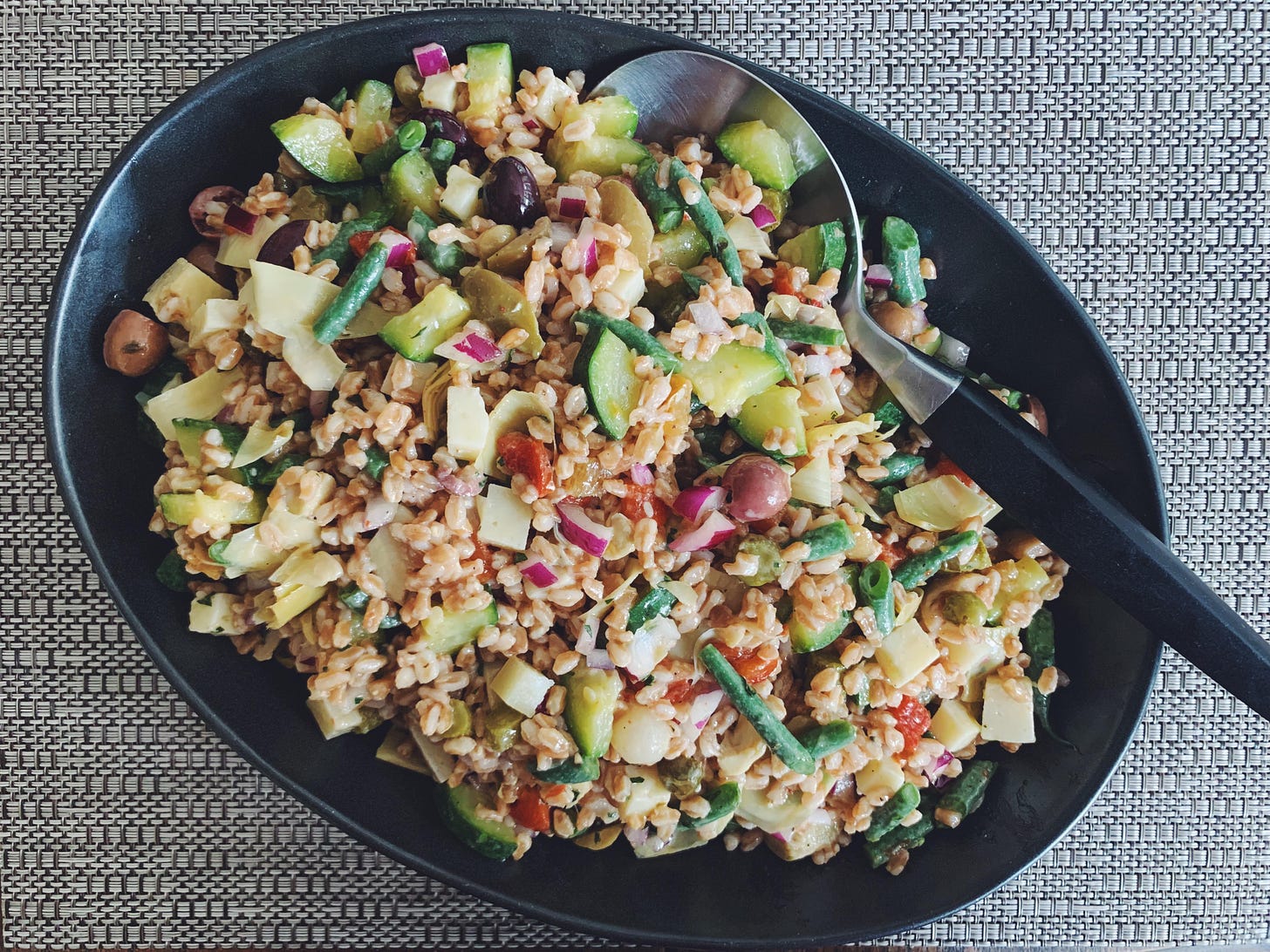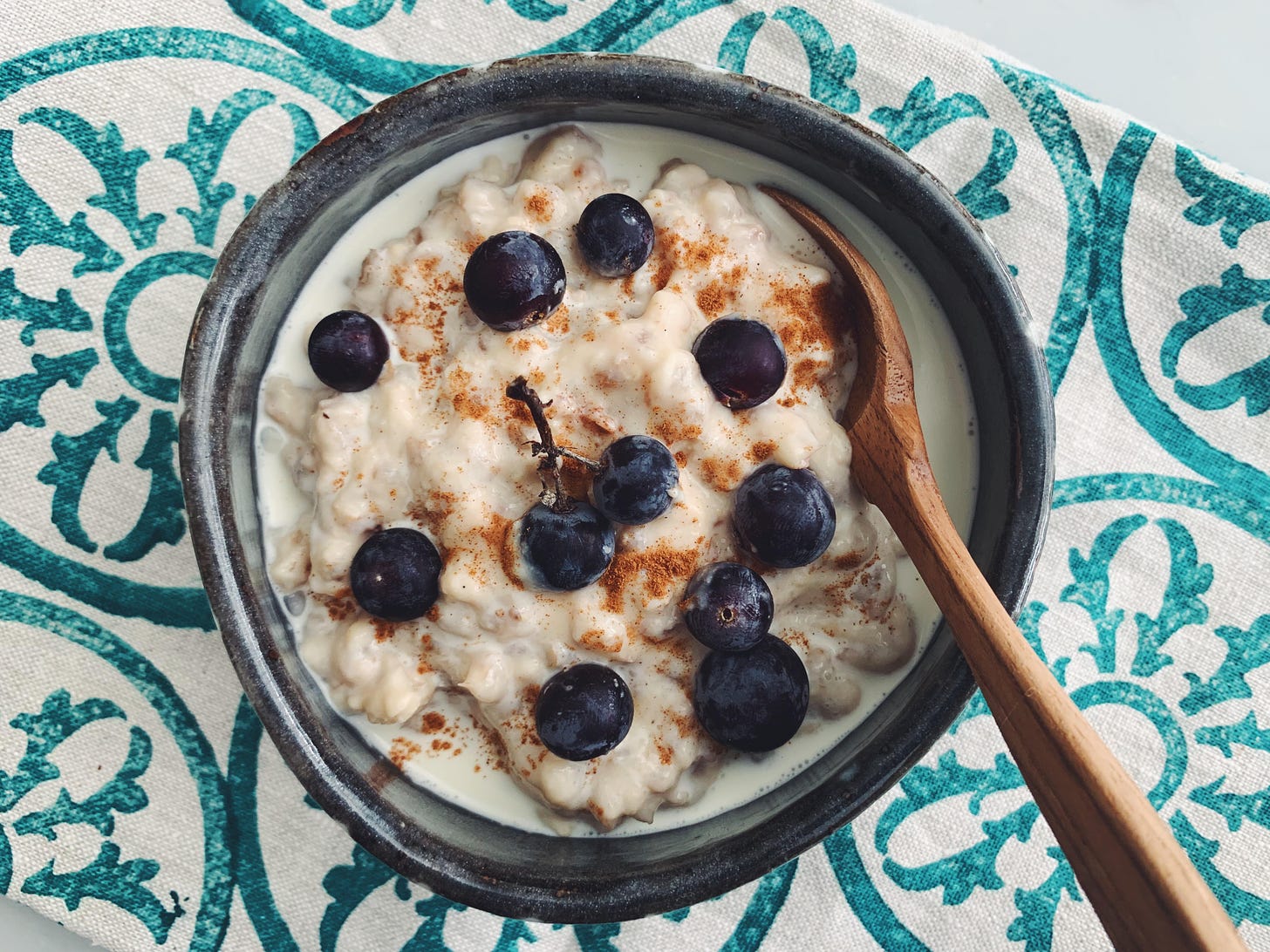Farro, Savory and Sweet
Three recipes featuring my favorite ancient grain to welcome September
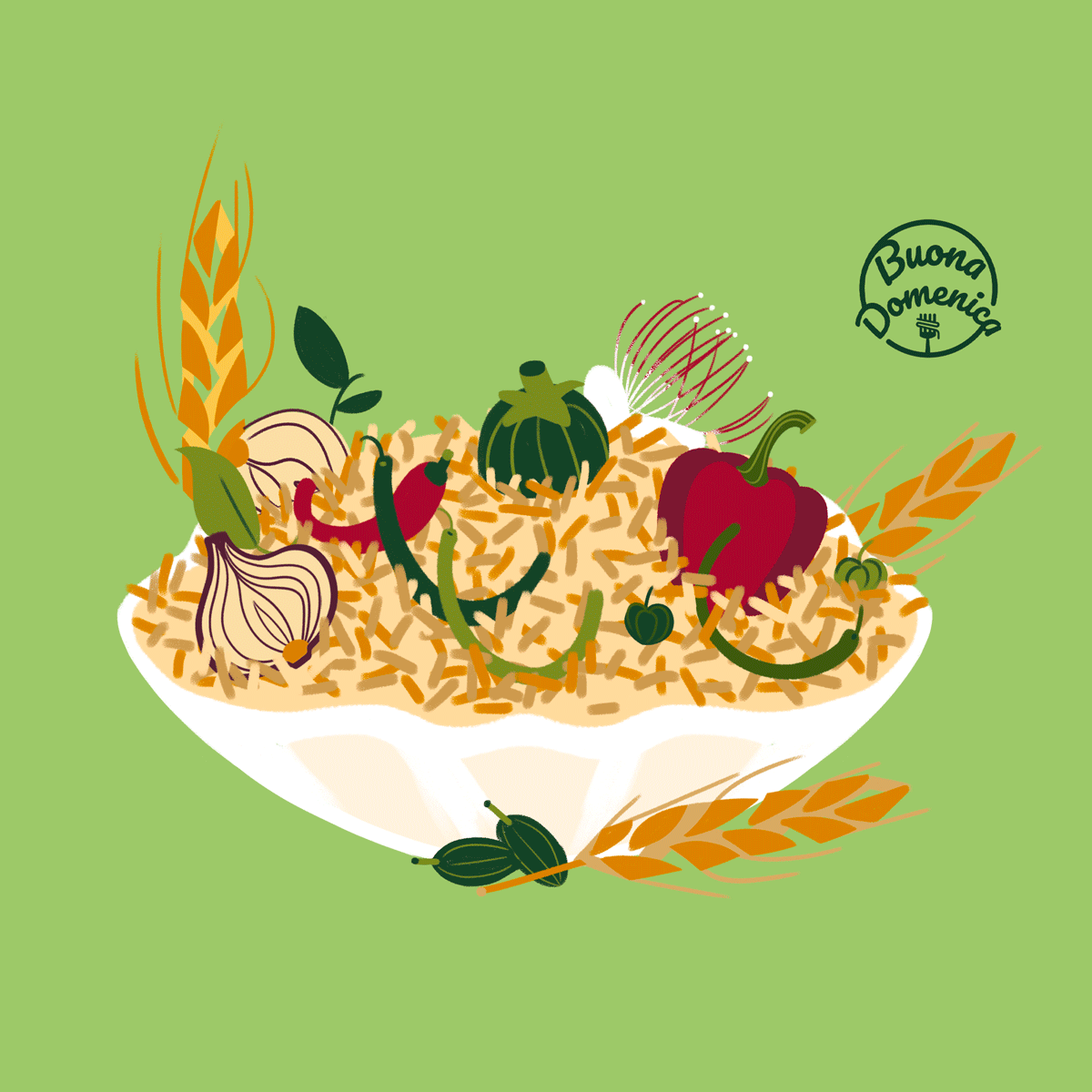
Welcome September, and welcome new subscribers! Buona Domenica is a weekly newsletter of inspired Italian home cooking. A friendly reminder that after three (long) months, I am back to my normal newsletter schedule posting once a week (plus occasional bonus posts) so I have turned the paid subscription function back on. If you are a paid subscriber, your payment schedule has resumed as of last week. If you are a free subscriber who has been intending to upgrade to a paid subscription (and I sure hope you are), you can now do so by clicking the button below. Paid subscribers have access to all new recipes, plus benefits such as discounts on my online cooking classes (which will resume later this fall), cookbook giveaways, and other perks.
In celebration of September, I’m sharing three recipes in this week’s newsletter. The recipe for Budino di Farro (Sweet Baked Farro Pudding) is for all subscribers (see below), while the recipes for Insalata di Farro (Farro Salad) and Zuppa di Farro e Ceci (Farro and Chickpea Soup) are behind the paywall. Those of you who know my work know how much I put into the testing and writing of recipes. I hope you’ll understand why I can’t share them all free of charge.
On to the newsletter…
Who among us can honestly say they remember the first time they tasted farro?
I can! I remember it well, which is saying something since in general I have a lousy memory. But I remember this. Midsummer 1994 at a lovely restaurant in Lucca called Antico Ristorante Caffè delle Mura, with my husband and my parents.
Lucca, as you may already know because it’s become a hugely popular tourist destination, is a splendid medieval city west of Florence with an oval piazza that was once an amphitheater and more than 100 churches, a few dating to the 12th and 13th centuries. The centro storico is enclosed within three walls, or what remains of them. The outer wall, still intact, is actually a broad, bucolic tree-lined boulevard that is (thankfully) closed to cars but open to pedestrians and bicyclists. It is here that the restaurant was located.
In my memory, we sat out on a covered terrace. I remember lots of tables around us, filled with cheerful, chatty diners, and, along a wall next to a doorway leading back into the restaurant, a drinks cart of sorts on which displayed an impressive array of bottles and bottles of Tuscan olive oils.
I wish I could remember the entire meal, but I only remember the soup and the waiter explaining to us what farro was—an ancient variety of wheat grown in the rugged Garfagnana part of Tuscany that includes Lucca. The soup was simple, which is perhaps why I remember it so fondly; just farro cooked with aromatics—celery, onion, carrot, a little tomato, possibly beans—and served with a light drizzle of one of those Tuscan oils. It tasted earthy, and I loved the chewy-tender texture and nutty taste of the grain. (Fourteen years later, when my husband and I took our two young kids to Lucca, we were truly sad to see the restaurant closed and the building marred by graffiti. I’m sorry to say it’s still closed, according to my friend Stefano, who lives part-time in Lucca, though apparently, if recent internet photos are to be believed, the graffiti has been removed.)
After my memorable encounter with farro, I brought a bag of the grain home to the U.S. and set about recreating the soup. Then I made a farro salad, a riff on my Zia Gilda’s insalata di riso, and a farro version of risotto. I wanted to write about this (to me) miraculous, delicious, nutty grain that could be employed not just in soups but in all sorts of ways. But at the time I was a newspaper beat reporter covering zoning board meetings and the occasional grisly murder in suburban Detroit. It would be years before I reinvented myself as a freelance food writer and began pitching stories to cooking magazines.
The one that finally bit was Cooking Light, in 2001. It was the first or second of many articles I wrote for the magazine before it ceased publication at the end of 2018 (RIP). The catch was that I had to call the grain “spelt” in the article because the editors were worried that readers wouldn’t be interested in a grain no one had heard of or had access to, a valid concern. Not that many people had heard of spelt back then, either—health food stores were the only places that carried it. I acquiesced. I was happy for the work. (I am always happy for the work.)
It's not that spelt isn’t farro. It is, sort of. There are three types of farro, distinguished by their size:
Triticum monococcum: farro piccolo, or einkorn here in the U.S.
Triticum dicoccum: farro medio, or emmer
Triticum spelta: farro grande, or spelt
In Italy, farro medio (emmer), is the most common variety and that’s what you’ll get if you order Zuppa di Farro alla Garfagnana at a restaurant in Lucca or a farro salad at Nonna Ersilia, in Penne. In any case, the Cooking Light story gave me an opportunity to develop recipes that I still make today, including a sweet baked farro pudding that I later included in my second book, Big Night In, and am sharing here. Think cozy rice pudding, slightly earthier. I love it, especially chilled with cold cream poured over.
There are plenty of sources for farro—all three types—these days. I’ve listed some links below. The other important detail to note about farro is that most of the farro available is either semi-pearled or pearled, meaning that it has been ‘polished’ to remove part or all of the bran. This is the nutritious but tough outer coating of the grain. It contains fiber, protein, and fat, but whole farro takes a lot longer to cook than the other two.
I cook with farro all year long, but I especially like it now; it’s a wonderful “bridge” ingredient, bringing together end-of-summer and early fall flavors.
Readers: Do you cook with farro? What’s your favorite way to prepare it?
ONLINE SOURCES FOR FARRO
Gustiamo (NY), one of my go-to resources for Italian ingredients, carries both farro dicoccum and farro monococcum, from Umbria.
Olio2Go (VA), another favorite online resource, carries farro dicoccum from Rustichella d’Abruzzo.
Bob’s Red Mill (OR) doesn’t specify which variety, but I’ve used it and it’s high quality.
Hayden Flour Mills (AZ) carries emmer farro (farro dicoccum), as well as farro flour, which I use often in baking, and farro crackers.
Janie’s Mill (IL) has an entire section devoted to ancient grains, which includes all three varieties of farro.
Wade’s Mill (VA) carries spelt flour (Triticum spelta). I did not see a whole grain option on the website.
BOOKS THAT FEATURE ANCIENT & HERITAGE GRAINS
Here are three of my favorite cookbooks that use farro and other ancient/heritage/heirloom grains and flours in creative and well-constructed recipes:
Ancient Grains for Modern Meals, by Maria Speck. Recipes for everything from appetizers to desserts, as well as breakfast, brunch, and bread.
Good to the Grain, by Kim Boyce with Amy Scattergood. One of my all-time favorite baking books. Boyce, pastry chef and proprietor of Bakeshop, in Portland, OR, has a way of effortlessly showcasing the attributes of whole-grain flours from amaranth to teff. Her award-winning book includes a chapter on spelt flour, but I also love what she does with barley, kamut, oat, and rye flours.
The Miller’s Daughter, by Emma Zimmerman. I mentioned this book in last week’s newsletter, but it’s worth another mention here. Recipes feature flours inluding corn, chickpea, einkorn, farro, and rye.
THIS WEEK’S RECIPES:
1. Baked Sweet Farro Pudding
2. Insalata di Farro (for premium subscribers)
3. Zuppa di Farro e Ceci (for premium subscribers)
RECIPE: Budino di Farro
(Sweet Baked Farro Pudding)
This sweet, slow-baked pudding, originally published in my book Big Night In, is similar to rice pudding, cozy comfort food in the form of dessert. The farro is baked in cinnamon- and lemon-infused milk (or a mix of milk and cream) for several hours in a low-temperature oven, with nothing more than a little stir now and again to help it along. It takes a while, but it is easy to make and well worth the wait, for what emerges is a lovely, thickened cream the color of caffe' latte, in which the fat grains of farro are suspended like rough-textured pearls.
You can enjoy the pudding warm, as you might be inclined to do in winter. But, again, you will be rewarded if you wait a few more hours and allow it to chill completely in the refrigerator. Eaten cold, this pudding is a luscious treat any time of year, a mood lifter with its flowery aroma of cinnamon and citrus, cool and soothing by the spoonful. Serve it topped with a drizzle of fresh cream or a dollop of whipped cream. Or go fancy and top it with toasted coconut flakes, caramelized banana slices, or roasted grapes.
Makes 6 (or more) servings
INGREDIENTS
1/2 cup (90 g) semi-pearled or pearled farro, rinsed and drained
4 cups (1 L) whole or reduced-fat milk, or 3 1/2 cups milk (370 ml) and 1/2 cup (120 ml) heavy or light cream
1/2 cup sugar
1/4 teaspoon fine sea salt
1/4 teaspoon ground cinnamon, plus more for sprinkling
2 (3-inch) strips lemon peel
1 vanilla bean, split lengthwise
Vegetable oil for coating the baking dish
Cold heavy cream or whipped cream for serving (optional)
INSTRUCTIONS
1. Place the farro in a medium-sized saucepan and add water to cover by 2 inches. Bring to a boil and boil for 2 minutes. Remove the pan from the heat, cover, and let sit for 15 minutes. Drain the farro in a colander and transfer it to the work bowl of a food processor fitted with the metal blade. Pulse just until the grains are coarsely ground, 30 to 45 seconds.
2. Heat the oven to 275° F (135° C). In a large bowl, combine the farro, milk, sugar, salt, cinnamon, and lemon peel. Scrape the seeds from the vanilla bean into the mixture and add the pod as well. Mix well. Coat a 2-quart (2 L) oven-proof baking dish with a little oil—I use a soufflé dish. Pour the mixture into the dish and place in the oven. Bake the pudding, uncovered, for 3 1/2 to 4 hours, until thickened and creamy. Stir it briefly every hour or so to prevent a skin from forming. If there is a skin, just stir it back into the pudding.
3. Remove the pudding from the oven. Discard the vanilla pod and the lemon peel if you can locate the peel; otherwise leave it in. Place a sheet of plastic wrap directly over the top of the pudding and refrigerate until thoroughly chilled.
4. To serve, spoon the pudding into individual custard cups and garnish with a drizzle of cream or dollop of whipped cream, if you like, and a sprinkle of cinnamon.
Keep reading with a 7-day free trial
Subscribe to Buona Domenica to keep reading this post and get 7 days of free access to the full post archives.





